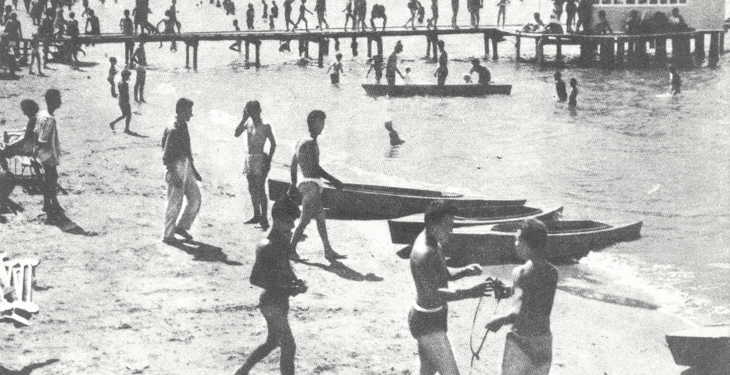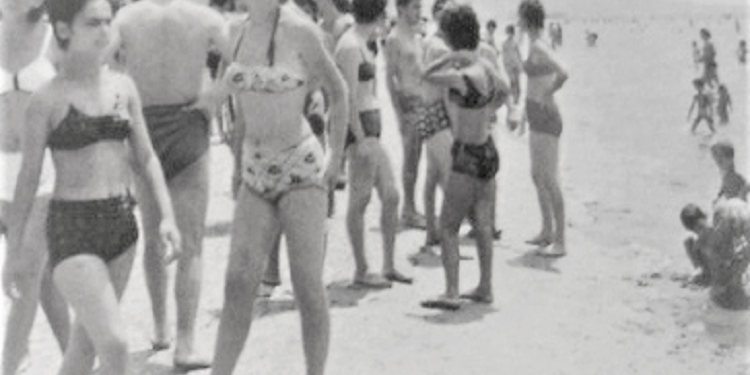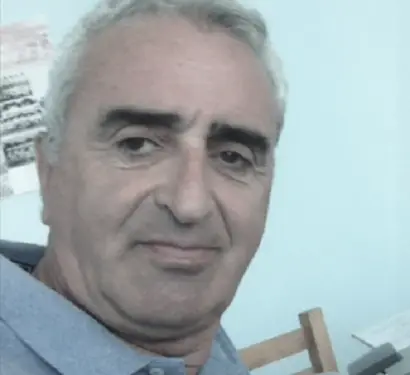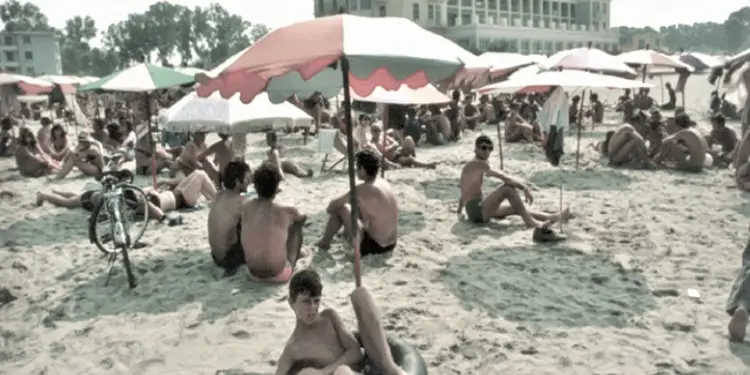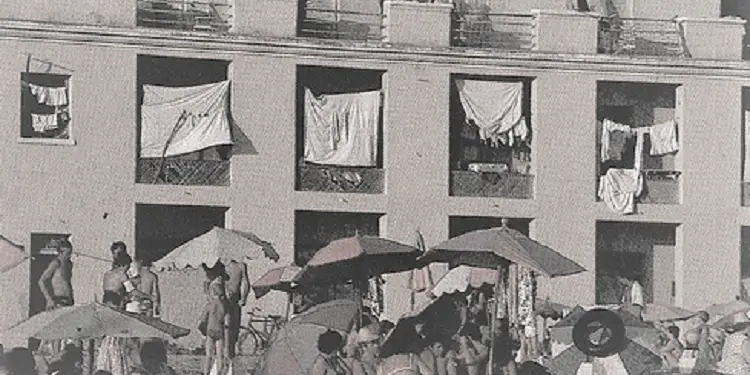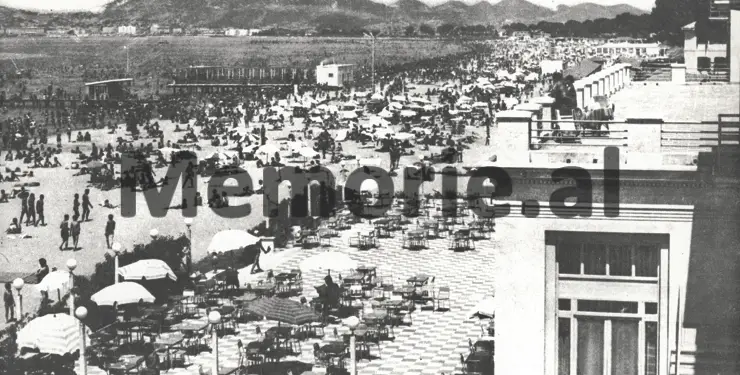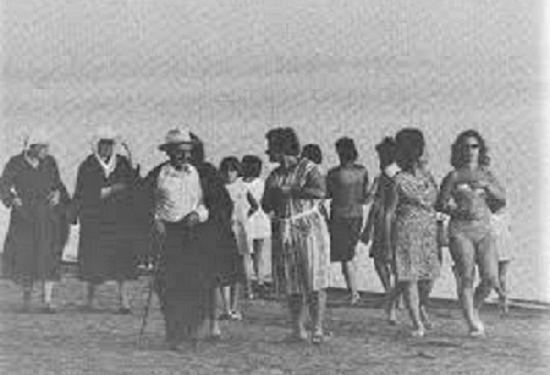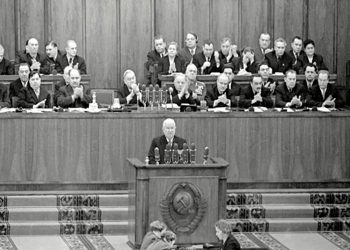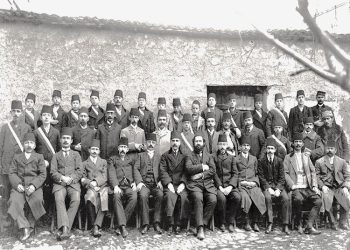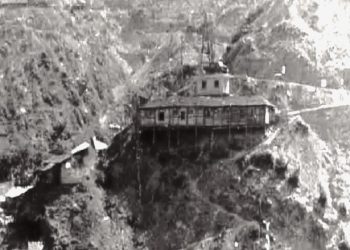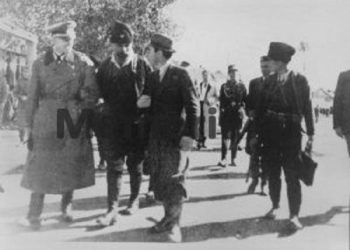From Uvil Zajmi
The third part
Memorie.al/ What were the favorite beaches, and how did Albanians vacation before and after the 50s, especially those who preferred the sea? Durrës, the most important one, in the three months of summer, frequented by the aristocracy, the wealthy, but also by King Zog himself. Then the period of the 1960s – 70s – 80s were special for Albanians, individuals or families who loved the sea. In those beginnings, the beaches were few and Durrës, Vlora, Saranda were the most important ones. Shengjini started to be preferred later, as well as Divjaka, while Dhërmiu, or the Ionian coast, although it was liked, was limited by the distant, difficult journey and the limited possibility for systematization.
Continues from last issue
Chambers of Chams
They were very popular and in demand from the mid-70s onwards. Since the flow and the only possibility to spend 15 days on the beach of Durrës, always created difficulties in finding a cabin or room for those families who did not have a work relationship from which they could get an authorization, or for those who wanted to take vacations of more than two weeks, the so-called “cham rooms” were born, which was a solution. They were families settled for years, mainly in the “Railway” area in several entrances, with one or two rooms, which they gave during the beach months.
They were located across the national road and you had to guarantee them at the beginning of the year, that is, in January. A cham room for a 30-day period cost 3,000 ALL (half of a monthly salary at the time). Many families from Tirana had created a clientele with the owners of the Cham rooms, and for years you systematically found them in the same apartment. Meanwhile, although it was known, the state did not react; it had even quietly allowed them.
The productions of N.I.SH. – Tires – Durrës
They were very special for the time, in particular the sea slippers produced by N.I.SH. Durres tires. They cost only 170 lek and were mainly used for movement on the beach, especially during lunch hours, when the heat of the sand was very high. Their production and marketing began to be intensive, they were sought after and at first there were difficulties to find them. They were a simple model with two straps, but the quality was poor and they were damaged very quickly. For many years they have served as beachgoers, together with water caps (swimming caps), they were also produced by NISH Goma-Durrës.
Sand and ball games with Italian footballers
The football matches at “Breshka” have been spectacular. Rivalry, competition in love, clothes, also appeared a lot in football. With small gates, on the strip of the sea coast, twice a day, at ten o’clock and five o’clock in the afternoon, two matches were played, with four or five players between the Tirana and Durrsak players. The interest was very great, even those present surrounded the place where the meeting was played, in an area no more than 20 meters long. There were no fixed rules, no referee, with improvised gates with a reference point a stick on the sand and everything was decided by the players, their honesty, and their conscience.
Even a policeman, who was tasked with maintaining order on the beach, mainly not allowing the ball game on the sand, remained passive, since such a thing had become a tradition and it was difficult to stop it. In many cases, they did not end because of a goal or a controversial case, a fight broke out and the game was interrupted, a tense situation was created, erupted, but that also had its own charm. Then the next day again opposite. There were periods when famous footballers also played in them. But the most special thing was the ball that was used.
Especially in the time after the “European 68”, where Italy was declared champion, in Italy, beach balls with the faces of Italian players were produced and put on the market, which also appeared in Durrës, especially in the sand matches. The curiosity to see the ball up close was very great. You had to stand behind the goal, when the ball went out, in the sand or in the sea, so that you had the opportunity to run after it, pick it up, watch it and then quickly return it to the players.
Beach fashion, swimwear and sunglasses…!
If you go back to that time, the way they were prepared, where they were and what fashion was followed on the beach will seem special to the memory. We are in the 1960s-’70s, when the age, effects and influences of Italian Radio-Television, mainly for a change, the passion for a different life in particular of the youth is at its peak, for everything. Everyone was running after fashion and a pair of beautiful swimwear was the main and important object in those three months, without exception for boys and girls. A pair of beautiful bathing suits was also used as a means of teasing the girls. But there was very little income from abroad, the rest was sewn here.
First the cloth was found, then the tailor. In particular, the latter was very important, they were known by fingers, since a beautiful stitch gave value and completed the physical structure of the boy or girl. Always the most privileged and who was the protagonist of the beach, he remained the one who had the opportunity to bring from abroad. Even in this case, the Durrsaks, or the sailors, or those with Italian parents, were the first. A new pair of bathing suits was taken as a model and imitated by many young people, even borrowing for a day, or going out for a walk. But sunglasses were also important. Such a pair was a favorite for both boys and girls. They were also borrowed, just for a transfer to “Turtle”.
“Leadership block, forbidden zone…!
It was a part with a length of about 1 km., which bordered the area from “Illyria” to the Convalescence of the Ministry of the Interior. King Zog wanted to make it a very special and favorite area, since in addition to the sandy part and the sea; it was characterized by a belt of pines and poplars that created a very modern environment under the name “Royal Baths”. At the end of the 40s, it was fully nationalized, it was restricted by being surrounded and protected by soldiers and it got the name “Zona e Bllokut”, identical to the one in Tirana. That area was several hectares where no one could approach and entry into it was prohibited. Until 1990, senior leaders of the state party, together with their families, used to spend the summer or winter there.
Entertainment: Summer cinema and Circus
There were few forms of entertainment: the summer cinema, one where the evening was spent, and the Circus. Summer cinemas were only during the summer months, even preferred. In Plazh, it was located across the street, next to the P.T.T., at the “Railway”. The hours were 19-21, 21-23, less 23-01, after midnight. When the movie was good and in demand, you had to leave the beach to guarantee a ticket, as they went on sale in the morning and there were long lines. A ticket cost 20 ALL for the first 7 rows and 15 ALL for the ones after that. On the black market, and just moments before the film starts, the price doubles. The capacity was normal, 20 rows with 15 wooden and iron chairs each. For those who couldn’t find tickets, they could follow it from the street, as the big screen was up and gave you the chance to see part of it, especially when it got dark.
The cinema was surrounded by a wall up to two meters high. Among the films of the time, there were the Italian ones, “Forgive me”, “Protect my love”, “The man in shorts”, “Listen to my song”, “Mercy for what falls”, with the actors Antonela Lualdi, Amedeo Naxarri, Raf Valone, or the film “View from the Bridge”, with Jean Sarel, the Hungarian film “Lelaja and Gabori”, etc. Chinese movies had just started showing, but the ones with Steve Revees were very popular. The films, all black and white, were controlled and were first shown in Tirana, and then distributed in other cities.
But also the troupe of the Circus of Tirana, at the beginning of every summer season, moved to the beach and to “Breshka”, they set up the big tent of the Circus and for three months, artists, comedians were systematic residents of the beach. Every evening there were performances for children, while during the day the large group of actors together with their families used the sea. They lived in small tents, where they slept and cooked every day. But also the Circus animals that entertained the children were the protagonists of the beach. This is only in Durrës, as the troupe did not move and there were no such artistic events on any other beach.
Photographs of time
This is also a very special detail for the time. It was fun to take photos on the beach, with friends and family. There were only a few photographers, mostly from Dursas, who with a camera hanging around their neck and very familiar with an extremely black hat on their head were moving all along the coast. The format of a photo is always black and white, (it was not a postcard that cost), but traditional for the time, 6 x 9 cm. and each photo was bordered with serrated cutouts.
For those who were on extended vacation, pictures were taken a day or two later, by the same photographer. For daily beachgoers, he sent them to Tirana, and took them to “Skenderbeu”, the place where the photographers stayed, since the photographer usually came on Tuesday, or he sent them to the studio of the same name near the “Donikas” hotel. One piece cost 13 Lek, but usually two pieces were stamped, so 26 Lek.
Athletes, favorite beach people
Sportsmen were also the characters of the time. They were popular because they were public, they had special clothes and clothing, unlike all the others, because they brought them when they went abroad, which made them famous. At the beginning of July, the sports clubs, in particular that of “November 17”, mainly footballers, basketball players, volleyball players, boys and girls, poured there and for 15 days, they were arranged in cabins, being treated in restaurants, mainly at “Teuta”. “Apolonia”, “Breshka” and “Illyria”, with coupons.
There were also those from Durrës, while those from “Partizani” and “Dinamo” were not missing, as their athletes were staying in the respective Convalescences, buildings that were close to Plepa and to get to “Breshka”, they had to pass on foot, the “Block” area from the side of the highway. Also due to the fact that their movements were limited, however, there were those who secretly avoided the controls and you could find them at “Breshka”, mainly in the morning hours, less during the dinner rounds. Especially when they would meet their girlfriends.
However, the desire to be at “Breshka”, to make the famous tour, even in the role of the protagonist, was also the sons and daughters of high officials of “Blok”. Although “isolated” in that area, where they lived with their families, they felt the lack of a group entertainment, which prompted them to cross that small metal fence separating “Illyria”, and run with fast steps to “Turtle”. A few hours in the company, then the forced return to the “Block”. But, even in the evening, there was no shortage of people for the tour or the entertainment at the track. Of course, not all of them, but the bravest, the funniest and the ones who had friendships, especially with sportsmen and artists.
Rivalry between two cities
The Tiranians or the Durrsans, who opened the beach first? It has an unprecedented “race”. Although the people from Durrës claimed that they were the first to open the season closely, the competition in this direction was extraordinary, when from Tirana, on March 7, ‘Teacher’s Day’, especially when it was a weekend, the group of boys left with: Sel Agollin, Spiro Kashara, etc., to inaugurate the new season, accompanying it with a dive in the sea, despite the atmospheric conditions. An annual ritual and for a long period of time. (Sel Agolli and Ing. Spiro Kashara, were two well-known characters, ultra-fans of Tirona, who, together with a group of friends, continued to go to the Durrës beach every Sunday, for the whole year, until 2015, when they passed away).
While those from Durrës by train, bicycle, or bus line, Durrës-Plepa, you would also see them on the beach. Then the race for fashion, who behaves, was the first to display it. The people of Durrës were more favored, as they had sailors as well as a “Commission shop” in Durrës, where you could find seized sailors’ clothing. So in a way they were masters of the beach. To continue with the race who swims better or the one who does the Teuta-Ilira distance, in the early hours of the morning? Such a race was not for girls, as they were more reserved, at least until the early 60s, when this ratio also changed.
Voice center: “A child is lost….!
She was also very special. Mainly at the “Railway”, where the Police Region was also. It was used for announcements, when from a loudspeaker placed on a pole, it was heard: Notice, notice, a child of the age of…… has been lost! Anyone who sees him, please notify the family immediately. And, yes, from that region, there were two uniformed policemen performing police service along the coast, who should take care of order. Especially for those who played in the sand, or on the beach. They would take the ball, break it, or take it to the region, and you could hardly get it anymore. But it happened that it was enough for someone to call the “police”, everyone would leave the game and run into the water, which was impossible for the police.
“liria”, the most populated area and for everyone
How was the beach designed next to the residences of the communist leadership? From the cabins without bathrooms to the VIPs of “Blok” and eastern tourists, what was the beach like before the 90s at “Iliria”, who frequented that area? With a wide and long extension, the beach of Durres had several points, favorite sectors, one of which was and remains “Iliria”. Even today, it continues to be known as such, but with a big difference from the years of attendance, as little remains from that time.
With a name from mythology, this sector is the fourth in line after the first “Teuta”, “Apollonia” and “Hekurudha”. An area of about 200 meters of coastline, “Iliria” was a popular beach, more for the people of Tirana, unlike “Teuta” and “Apolonia” which were also used by vacationers from other cities. The “Railway” remained the center of preference with the “Turtle”, the Track and the “Adriatik”, where the foreigners stayed.
The area of ”Illyria” began with the Workers’ Camp; a three-story building from the east, next to the main road intended only for distinguished employees and next to it the “Workshop Building”. While north-south, it was bordered by two parallel roads about 150 meters away from each other and in the space between them, in the shape of a square were the cabins for the population. “Illyria” was also known for its proximity to “Blok”, where the leadership was located, with which it was formally separated by a wire fence, and the soldiers at the ready and armed controlled everything.
Then came the Plepa station, where the bus of the Durrës-Plepa line took a turn, the two Convalescences, that of the Ministry of Interior and Defense, and between them the Camp of Pioneers. Favorites in “Iliria” were also the few villas reserved for a select elite, (the villa of Myslym Peza, Rita Markos, Major-General Spiro Moisiut, etc.), as they had much better conditions than the cabins of family members.
The maintenance of the cabins was taken care of by the office with the employees of the beach administration, since each sector had one. For the population, wooden cabins from the work center. There is no Albanian who has not spent a day, a fortnight, or a weekend in the famous cabins on the Albanian beaches, especially in Durrës. Once a one-day cabin, then a 15-day cabin, the main block in the “Illyria” area, was built in the mid-60s, and they were made of boards and walls.
The cabin was obtained with authorization from the work center, and with it, you had the beach tent (150 ALL), two beds, in many cases typical for sailors, mattresses and covers. As for the key, you had to pay 150 ALL as a down payment in case you lost it, much of which you received when you handed it over on your way out, as you had to wash and clean the cabin. Years later, you would also find a Gjirokastra kerosene furnace, and therefore you had to take a kerosene drum with you.
The 1-story wooden cabins were in several horizontal and vertical rows on top of each other, with few steps and cost 2,800 to 3,500 ALL. A row of cabins, single and highly sought after, were those on the sand, overlooking the sea, while another group, but on the side of one of the parallel roads, were those with a back from the “Block”, where only the families of employees, management companions.
The maintenance of their cabins was taken care of by the office with the employees of the beach administration, since each sector had one. The journey from Durrës to “Iliria”, or vice versa, was carried out by regular buses, the accordion ones, always overcrowded, people pushing, even in many cases the buses did not stop there, or stayed a little further away and people ran for it riding It was often preferred to walk to Plepat, to find and take the free bus.
Even tents with authorization, queues for the bathroom and drinking water!
On the side of the highway, at the traditional station at “Iliria”, as soon as you get off, almost next to the Workers’ Camp, there was a concrete platform square, where, until a certain time, large portable tents, erected by the beach administration, were placed where family members, athletes stayed, as a second alternative when you could not secure a cabin, but these were also given with authorization, according to a plan from the job centers where you worked.
Since the cabins and tents were without bathrooms, next to them and in the center of the “Illyria” sector, there was a large public toilet, (round in shape) for men and women, the only one in the entire area and in many cases were rarely created. Then water, which was a systemic problem, as it was constantly missing, because the supply of drinking water to the cabins, or to the area, was impossible. To come to the aid of vacationers, several improvised ambulance taps were placed at certain points, where you could endlessly see men, women and children in line with plastic bins in hand.
Likewise, there were a few improvised showers that did not work and in most cases, the vacationers showered in front of the cabin, with the water heated by the sun stored in the plastic basin. Every morning, they attracted the attention of the vacationers with the towel in their arms rushing to the taps, to perform the toilet and personal services. For those who could not afford cabins, or families who stayed more than two weeks on the beach, even in that area the houses or rooms of chams operated, which were located across the tracks. Memorie.al
The next issue follows






